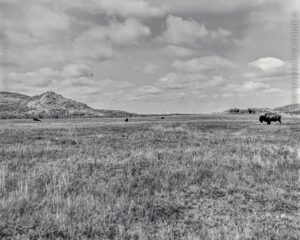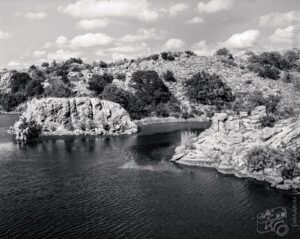![Crab Eyes [Crop] — Charon’s Garden Wilderness Area, Wichita Mountains Wildlife Refuge. The two boulders are each about the size of a minivan and are balanced on a narrow granite spine.](https://mercury.photo/wp-content/uploads/2018/08/czahller-20180819-19-06-47-2-2-1.jpg)
Trekking thru the Wichita Mountains Wildlife Refuge with a 4×5 Field Camera
Hiking thru the Wilderness
Shaggy Beasts, Three-Legged Beasts
Last Sunday [Sidenote:  Wista 45DX 4×5 field camera. This is the same camera I use for OKIE-X .] I drove out to the Wichita Mountains Wildlife Refuge near Lawton with custom leatherworker and hiking enthusiast Michael Parham. We intended to photograph the wilderness, and especially the rock formation called Crab Eyes, with a large format camera. Michael acted as guide and sherpa, carrying my Wista 45DX, a lens and shutter, six film-holders, and other camera gear in a Domke F-3X camera bag. Additionally he carried a small pack for my dark cloth, water, and snacks. For most of the day, I carried the Ries tripod. [Sidenote: Weighing a little over twelve pounds (5.45 kg), including the leveling base, geared head, and quick-release plate, this maplewood tripod is a beast. I still have bruises on my scapulæ from carrying it on my shoulders. Michael and I each used one of the tripod legs as a trekking pole. For the Crab Eyes descent, we switched loads.]
Wista 45DX 4×5 field camera. This is the same camera I use for OKIE-X .] I drove out to the Wichita Mountains Wildlife Refuge near Lawton with custom leatherworker and hiking enthusiast Michael Parham. We intended to photograph the wilderness, and especially the rock formation called Crab Eyes, with a large format camera. Michael acted as guide and sherpa, carrying my Wista 45DX, a lens and shutter, six film-holders, and other camera gear in a Domke F-3X camera bag. Additionally he carried a small pack for my dark cloth, water, and snacks. For most of the day, I carried the Ries tripod. [Sidenote: Weighing a little over twelve pounds (5.45 kg), including the leveling base, geared head, and quick-release plate, this maplewood tripod is a beast. I still have bruises on my scapulæ from carrying it on my shoulders. Michael and I each used one of the tripod legs as a trekking pole. For the Crab Eyes descent, we switched loads.]
After leaving the visitors’ center we turned back on the main road. We set up on the shoulder to capture a scene of a small bison herd grazing near the road, keeping a respectful distance. [Sidenote: National park regulations require visitors to maintain at least 25 yards distance from bison and elk. We figure that holds for state parks too. If we had seen any of the ubiquitous longhorn cattle we would have kept the same distance.]

Next we hiked the Kite Trail to Forty Foot Hole, a series of cascading pools on West Cache Creek. Lack of rain had reduced the sometimes impressive waterfall to a mere trickle, with storm debris and floatation devices left by careless hikers marring the otherwise picturesque view. A light breeze made the heat bearable and the burbling creek gave us a feeling of peaceful calm.
Dropping blood sugar and heat took their toll on me during the return descent. We stopped about ¾ way down so I could rest. Reaching the car, we both drank copious amounts of water and decided to drive to Medicine Park for lunch. We ended up on the patio of the Riverside Café. As the name implied, we had a view of Medicine Creek. We watched turtles, geese, and giant carp fighting for the potato chips someone had tossed on the water while we waited for a pleasant and filling meal, then headed back to the refuge.
Reservoirs & a “Haunted” Tower
We stopped at Lake Jed Johnson and took the stairs to the dam, where I set up the camera to capture the lake and the decommissioned fire watch tower. Although a trail leads to the tower, hikers are prohibited from entering it due to its dangerous state of disrepair. [Sidenote: The 60-foot tower resembles a castle fortification. The Civilian Conservation Corps built it from native stone in 1941. Numerous ghost stories surround it and the lake.]
Next up, we drove to Osage lake, another of the numerous artificial reservoirs dotting the park, and hiked down to the dam, where I took two images of the lake and the rocky cliffs and islands surrounding it. Finishing that, we hiked back to the car and drove to the Crab Eyes/Charon’s Garden Wilderness Trail.

Crab Eyes & Good Night
Arriving at the trailhead at about 6:30 PM, we entered the forest. Coming upon the trail fork, we turned right, away from the Charon’s Garden Trail and toward the Echo Dome/Crab Eyes trail. Continuing through the woods, we slowly gained altitude, eventually coming into the open.
From there we boulder-hopped and climbed, occasionally crossing narrow almost-creeks and muddy slashes fed by recent rains. Fatigue convinced us to stop below a rocky outcrop, where we enjoyed the shade and drank a little water. Resuming our trek, we crossed a short distance to the vista overlooking the gorge carved by Post Oak Creek. Below us lay Boulder Field, and to the west, the sun already behind it, stood our objective: two minivan-sized boulders balanced on the mountain’s narrow granite spine.
I made three bracketed exposures (+1, 0, and -1 EV, or 2, 1, and ½ seconds, respectively), [Sidenote: I had hoped that combining them in NIK HDR Pro would yield satisfactory results, but the software created unpleasant artifacts in the sky, notably a dark band along the mountain ridge and noticeable halos. I ended up using only the -1 EV exposure, with tonal adjustments made in Adobe Lightroom 6 and NIK Silver Efex Pro.] then packed everything up. We descended the mountain and walked through the forest in twilight. Michael checked the time about ten minutes before we reached the parking lot: it was 8:00 PM.

From there we drove to Meers, hoping to grab a bison burger, but the restaurant had closed for the day. We opted to take the back roads home. Stopping in Elgin, we shared some mediocre shortribs at a local franchise barbeque restaurant. [Sidenote: I won’t name names, but the restaurant chain bears the name of a prominent Oklahoma sportsball figure.] It wasn’t good — soggy ribs, anyone? — but it filled our bellies. We arrived in Norman late and said goodbye, vowing to return.
Blood-Sucking, Skin-Dissolving Arachnids
We plan to camp on the other side of Crab Eyes this fall and hike back to its east side to photograph the formation at dawn. On my to-do list: obtain permethrin to insect-proof clothing and percaridin to insect-proof myself (ticks and chiggers abound), and buy better hiking boots (already ordered). Optional: buy a Tilley “Endurables” hat and leave the cowboy hat at home.
Want to know when I post pictures from the next trip? Sign up for the newsletter. In the meantime, here are the pictures from this trip.
Thanks for reading,
Gallery: Bison, Water, Granite, Sky
Gallery: Bison, Water, Granite, Sky
Here are the best of the twelve photographs from the outing. Technical details follow the gallery.







![Crab Eyes [Crop] — Charon’s Garden Wilderness Area, Wichita Mountains Wildlife Refuge. The two boulders are each about the size of a minivan and are balanced on a narrow granite spine.](https://mercury.photo/wp-content/uploads/2018/08/czahller-20180819-19-06-47-2-2-1-300x240.jpg)

Technical
- Tripod
- Ries J100, maplewood with optional bronze knobs
- Tripod Head
- Manfrotto 438 leveling base, Manfrotto 410 geared head, & Hejnar Photo extended plate with F63 Arca-type clamp
- Camera
- Wista 45DX cherrywood field camera
- Lens
- Schneider Kreuznach Symmar-M 150mm ƒ/5,6 in Copal 0 shutter
- Filter
- Hoya 25A (deep red)
- Aperture
- ƒ/16
- Exposure
- Bison, Kite Trail: ¼ second
- Forty Foot Hole, Lake Jed Johnson, Osage Lake: ⅛ second
- Crab Eyes: ½ second
- ISO
- 100
- Exposure Index (3-stop adjustment/filter factor = 8)
- All images except Crab Eyes: 25
- Crab Eyes: 50
- Film
- Ilford Delta 100
- Developer
- Pyrocat-HD 1:1:200
- ~60 minutes semi-stand in an HP-Combiplan daylight tank
- Scanner
- Epson Perfection v850
- Software
- Vuescan
- Adobe Lightroom 6
- NIK Silver Efex Pro (selected images only)







